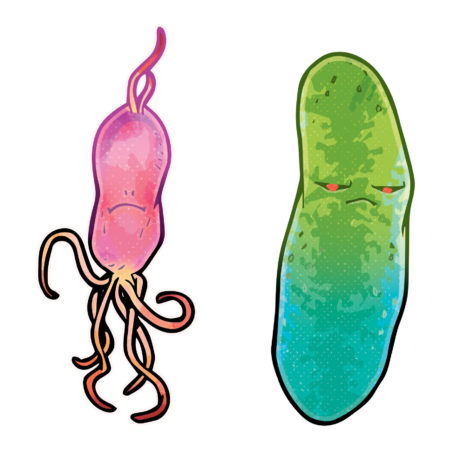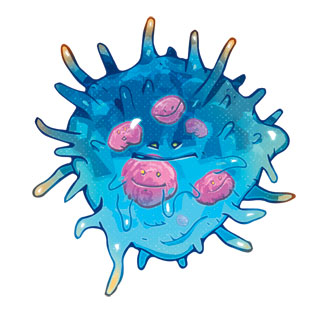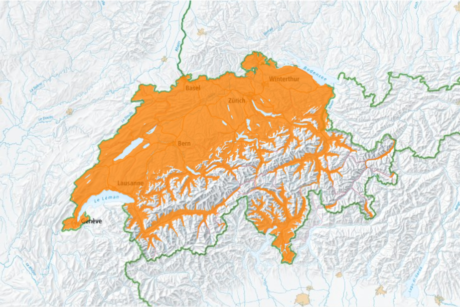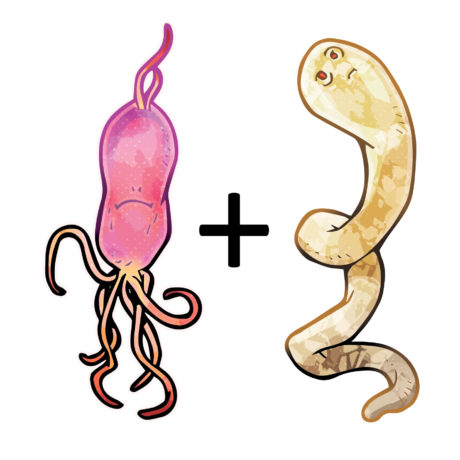By continuing your visit to this site, you accept the use of cookies.
Learn + I agreeLearn more
Which germs are transmitted by ticks in Switzerland?
At the institute of Microbiology of the University of Lausanne the researchers in the group of Prof. G. Greub are interested in ticks and tick-transmitted diseases. They have discovered chlamydia-related bacteria ( Parachlamydia and Rhabdochlamydia ) in ticks. These bacteria were not only found in samples from Switzerland, but also Algeria (1).
These results were validated in a larger cohort of 62,889 ticks collected in Switzerland and analyzed by PCR to amplify DNA belonging to the Chlamydiales order (2).

In this study 33% of the bacteria were related to Parachlamydia, 29% were related to Rhabdochlamydia, and 32% were new species related to Chlamydia.

The quantity of Rhabdochlamydia bacteria retrieved from ticks was so elevated that it has been possible to sequence the genome of multiple different strains (3).
A second study on the same specimens detected the presence of Anaplasma phagocytophilum in less than 2% of the Swiss ticks and no presence of Coxiella burnetii (4).

All bacteria of the Chlamydiales order are obligate intracellulars, which means they require a host cell to replicate and can therefore not be cultured by conventional microbiology media. This is also true for other bacteria such as Coxiella burnetii.
Others, such as Anaplasma phagocytophilum, Bartonella henselae, Legionella pneumophila or Mycobacterium kansasii can do both, but their growth conditions outside cells are labor-intensive and tedious. These type of bacteria are mostly detected by PCR, being more sensitive than culture (5).
During the last decade we have developed in Lausanne a co-culture method called amoebal co-culture (6,7). This system uses amoebas as hosts for the bacteria. It is not a diagnostic tool, but used for research to characterize novel bacterial species (8,9).

Lyme disease and tick-borne encephalitis
In Switzerland the main pathogens transmitted by ticks are Borrelia burgdorferi sensu lato and the tick-borne encephalitis (TBE) virus .
These two pathogens are unevenly distributed in Switzerland as can be seen in the maps below from the National Reference Centre for tick-transmitted diseases (NRZK)
orange: areas at risk of borreliosis (2018)
red: areas wher vaccination against tick-borne encephalitis is recommended (2021)


The cost for the vaccination against the viral tick-borne encephalitis is covered by the health insurance in the regions where it is endemic and even for visitors (no minimum stay required) (OFSP 2018) (11). To learn more about it check out the NRZK website (12).
Note also that next to Borrelia burgdorferi, there is another species of Borrelia, Borrelia recurrentis, that is transmitted by body lice and causes recurrent fever. This rare disease, mainly present in Africa, is manifested by intermittent febrile episodes
Interactive App “Tick Prevention”
If you have a tick bite don’t hesitate to use the app developed by Mr. Tischhauser, Prof. Grunder and colleagues (13).
This app allows you to send out an alert with precise geolocalization information that can be used to map tick distribution and risk assessment.
Contribute to research
You can further assist the research efforts by sending in your tick at the NRZK at the following address :
Laboratoires ADMED
Reto Lienhard
Rue de Chasseral 20
2300 La Chaux-de-Fonds.
There are three research groups associated with the NRZK
- Rahel Ackermann, Laboratoire Spiez, Spiez
- Reto Lienhard, Laboratoires ADMED, La Chaux-de-Fonds
- Gilbert Greub, Institut de Microbiologie, CHUV, Lausanne.
These three research groups analyze the submitted ticks for multiple pathogens anonymously. The techniques used range from pathogen specific PCRs, to full microbiota analysis of the ticks. This last technique called metagenomics is based on the amplification of the whole bacterial flora by PCR followed by high throughput sequencing.
This type of analysis allows to determine the relationship between different microbial species present at the same time within the tick. The interactions between the bacteria can be positive (synergistic) or negative (antagonistic).
For example a concomitant infection by Anaplasma phagocytophilum and Borrelia burgdorferi reduces the immune response to Anaplasma phagocytophilum and increases the transmigration of Borrelia burgdorferi through the blood-brain barrier (10).
Also the co-infection of Borrelia burgdorferi and Babesia microti increases the chances of transmission of the latter to ticks from mice.
An overview of these poorly understood interactions can be found in the following publication (10).

References
- Croxatto A, Rieille N, Kernif T, Bitam I, Aeby S, Péter O, Greub G. Presence of Chlamydiales DNA in ticks and fleas suggests that ticks are carriers of Chlamydiae. Ticks Tick Borne Dis. 2014 Jun;5(4):359-65.
- Pilloux L, Aeby S, Gaümann R, Burri C, Beuret C, Greub G. The high prevalence and diversity of Chlamydiales DNA within Ixodes ricinus ticks suggest a role for ticks as reservoirs and vectors of Chlamydia-related bacteria. Appl Environ Microbiol. 2015 Dec;81(23):8177-82.2.
- Pillonel T, Bertelli C, Aeby S, De Barsy M, Jacquier N, Kebbi-Beghdadi C, Mueller L, Vouga M, Greub G. Sequencing the Obligate Intracellular Rhabdochlamydia helvetica within Its Tick Host Ixodes ricinus to Investigate Their Symbiotic Relationship. Genome Biol Evol. 2019 Apr 1;11(4):1334-1344.
- Pilloux L, Baumgartner A, Jaton K, Lienhard R, Ackermann-Gäumann R, Beuret C, Greub G. Prevalence of Anaplasma phagocytophilum and Coxiella burnetii in Ixodes ricinus ticks in Switzerland: an underestimated epidemiological risk. New Microbes New Infect. 2018 Sep 6;27:22-26.
- Lamoth F, Schrenzel J, Greub G. Diagnostic approach of intracellular bacteria and fastidious microorganisms. Rev Med Suisse. 2014 Nov 12;10(450):2130-6.
- Tosetti N, Croxatto A, Greub G. Amoebae as a tool to isolate new bacterial species, to discover new virulence factors and to study the host-pathogen interactions. Microb Pathog.2014 Dec;77:125-30.
- Kebbi-Beghdadi C, Greub G. Importance of amoebae as a tool to isolate amoeba-resisting microorganisms and for their ecology and evolution: the Chlamydia paradigm. Environ Microbiol Rep. 2014 Aug;6(4):309-24.
- Lienard J, Croxatto A, Prod’hom G, Greub G. Estrella lausannensis, a new star in the Chlamydiales order. Microbes Infect. 2011 Dec;13(14-15):1232-41.
- Thomas V, Casson N, Greub G. Criblamydia sequanensis, a new intracellular Chlamydiales isolated from Seine river water using amoebal co-culture. Environ Microbiol. 2006 Dec;8(12):2125-35.
- Cabezas-Cruz A, Vayssier-Taussat M, Greub G. Tick-borne pathogen detection: what’s new? Microbes Infect. 2018 Jan 9. pii: S1286-4579(18)30004-2:
Learn more by other websites:
11. Vaccination against tick-borne encephalitis (in french) : https://www.infovac.ch/fr/?option=com_gd&view=listing&fid=58&task=ofile
12. NRZT : http://https//www.labor-spiez.ch/en/die/bio/endiebiorz.htm
13. Application Ticks: https://zecke-tique-tick.ch/en/
14. Interview of prof. G. Greub on vaccination against tick-borne encephalitis (in french) : https://www.youtube.com/watch?v=Eh9-81aL148
